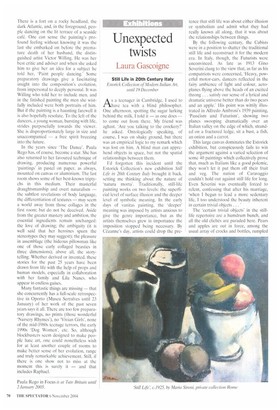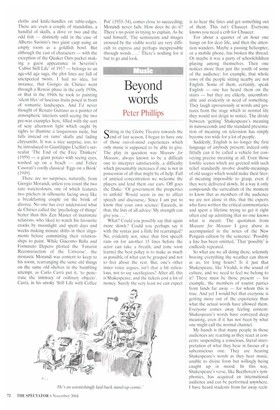Unexpected twists
Laura Gascoigne
Still Life in 20th Century Italy Estorick Collection of Modern Italian Art, until 19 December
Asi a teenager in Cambridge, I used to ave tea with a blind philosopher. One afternoon, spotting the sugar lurking behind the milk, I told it — as one does — to come out from there. My friend was aghast. 'Are you talking to the crockery?' he asked. Ontologically speaking, of course, I was on shaky ground, but there was an empirical logic to my remark which was lost on him. A blind man can apprehend objects in space, but not the spatial relationships between them.
I'd forgotten this incident until the Estorick Collection's new exhibition Still Life in 20th Century Italy brought it back, setting me thinking about the nature of `natura morta'. Traditionally, still-life painting works on two levels: the superficial level of surface illusion and the deeper level of symbolic meaning. In the early days of vanitas painting, the 'deeper' meaning was imposed by artists anxious to give the genre importance, but as the artists themselves grew in importance the imposition stopped being necessary. By Cezanne's day, artists could drop the pre
tence that still life was about either illusion or symbolism and admit what they had really known all along, that it was about the relationships between things.
By the following century, the Cubists were in a position to shatter the traditional still life and reconstruct it for the modern era. In Italy, though, the Futurists were unconvinced. As late as 1913 Gino Severini clung to the view that, as far as his compatriots were concerned, 'Heavy, powerful motor-cars, dancers reflected in the fairy ambience of light and colour, aeroplanes flying above the heads of an excited throng . . satisfy our sense of a lyrical and dramatic universe better than do two pears and an apple.' His point was wittily illustrated in Alfredo Ambrosi's 1939 painting, Passeism and Futurism', showing two planes swooping dramatically over an Italian valley on the edge of which, stranded on a fractured ledge, sit a bust, a fish, an onion and a carrot.
This large canvas dominates the Estorick exhibition, but conspicuously fails to win the argument against a varied selection of some 40 paintings which collectively prove that, much as Italians like a good polemic, they won't let it put them off their fruit and veg. The nation of Caravaggio couldn't hold out against still life for long. Even Severini was eventually forced to relent, confessing that after his marriage, 'when I began to lead a more sedentary life, I too understood the beauty inherent in certain trivial objects . '
The 'certain trivial objects' in the stilllife repertoire are a humdrum bunch, and all the old clichés are paraded here. Pears and apples are out in force, among the usual array of crocks and bottles, rumpled cloths and knife-handles on table-edges. There are even a couple of mandolins, a handful of skulls, a dove or two and the odd fish — distinctly odd in the case of Alberto Savinio's two giant carp using an empty room as a goldfish bowl. But although the cast of characters — with the exception of the Quaker Oats packet making a guest appearance in Severini's 'Cubist Still Life' of 1917 — belongs to an age-old aga saga, the plot lines are full of unexpected twists. I had no idea, for instance, that Giorgio de Chirico went through a Renoir phase in the early 1930s, or that in the 1940s he took to painting 'silent ides' of luscious fruits posed in front of romantic landscapes. And I'd never thought of Renato Guttuso as a painter of atmospheric interiors until seeing the two pre-war examples here, filled with the sort of sexy afternoon light which ought by rights to illumine a languorous nude, but Falls instead on rams' skulls and fading chrysanths. It was a nice surprise, too, to be introduced to Gianfilippo Usellini's surrealist 'The End of the Free Thinkers' (1959) — a giant potato with seeing eyes, washed up on a beach — and Felice Casorati's coolly classical 'Eggs on a Book' (1949).
There are no surprises, naturally, from Giorgio Morandi, unless you count the two rare watercolours, one of which features two pitchers in silhouette facing away like a breakfasting couple on the brink of divorce. No one has ever understood what de Chirico called the 'psychology of things' better than this Zen Master of inanimate relations, who liked to watch his favourite crocks by moonlight and spent days and weeks making minute shifts in their alignments before committing their relationships to paint. While Giacomo Balla and Fortunato Depero plotted the 'Futurist Reconstruction of the Universe', the monastic Morandi was content to keep to his room, rearranging the same old things on the same old shelves in the bumbling attempt, as Carlo Carra put it, 'to penetrate the intimacy of ordinary objects'. Carra, in his smoky 'Still Life with Coffee Pot' (1933-34), comes close to succeeding; Morandi never fails. How does he do it? There's no point in trying to explain. As he said himself, 'The sentiments and images aroused by the visible world are very difficult to express and perhaps inexpressible through words ... ' There's nothing for it but to go and look.



























































































































 Previous page
Previous page